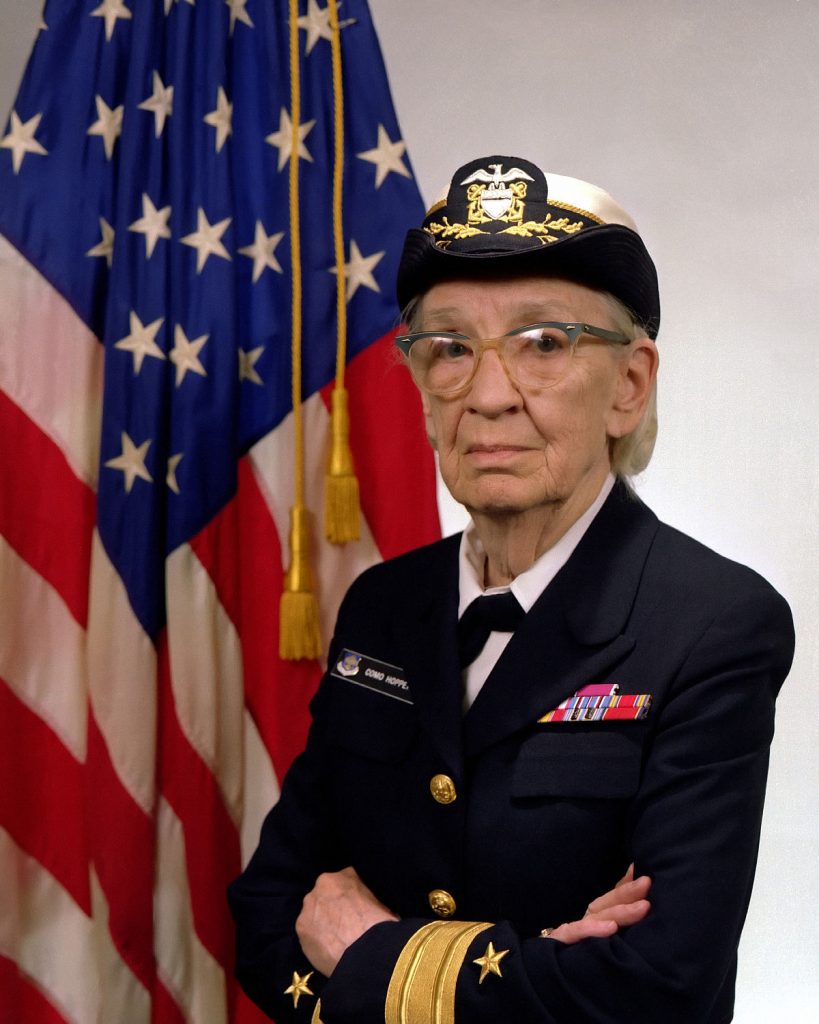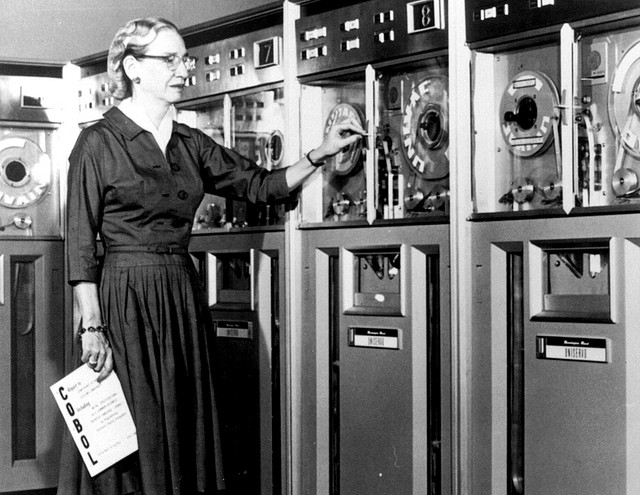Grace Brewster Murray Hopper was a United States Navy rear admiral and a computer scientist who was one of the Harvard Mark I’s first programmers. Hopper was a computer programming pioneer and she was one of the first inventors of tools related to compilers. During World War II, she had attempted to enlist in the Navy, but she was told she was too old to enlist, so instead she joined the Navy Attempt.
On December 9, 1906, Grace Brewster Murray was born in New York City to Walter Fletcher and Mary Campbell Van Horne Murray, their first of three children. Murray’s parents came from Dutch and Scottish ancestors. They both attended West End Collegiate Church in New York.
As a child, Grace Murray was extremely curious, and she carried this trait on throughout her life. When she was only seven, she was determined to figure out how alarm clocks worked. So, she dismantled seven alarm clocks. When her mother found out, she only allowed Murray to use one. She attended Hartridge School for preparatory school, then applied to Vassar College at sixteen for early admissions, but was rejected due to low Latin test scores. The next year, she was admitted though. In 1928, she graduated with a bachelor’s degree in mathematics and physics. For graduate school, she attended Yale University, earning an MA in 1930 and then in 1934, a PhD in mathematics. In 1931, she had started teaching math at 1931 before becoming an associate professor ten years later.
Grace Murray married Vincent Foster Hopper, a professor from New York University, in 1930 and they were married for fifteen years, divorcing in 1945. After their divorce, she did not remarry, though kept his name.
At the beginning of World War II, Hopper tried to enlist in the Navy. But because she was thirty-four, she was considered to be too old. On top of that, her weight to height ratio was too low to be enlisted. Hopper also tried to enlist because she believed her job as a mathematician and mathematics professor would be valuable to the war, but was denied as well. In 1943, she was able to get a leave of absence from her job at Vassar and was sworn into the United States Army Reserve. The minimum weight to join the Navy was 120 pounds, and she was fifteen pounds under, so to enlist, she had to receive an exemption. In December, she reported in to train in Massachusetts at the Naval Reserve Midshipmen’s School located at Smith College. When she graduated, she was first in her class. From there she was sent to Harvard University where she worked on the Bureau of Ships Computation Project. Hopper was apart of the staff who worked on programming the Mark I Computer. Howard H. Aiken, who headed the programming staff, co-wrote three papers on the Mark I with Hopper. At the end of the war, Hopper then attempted transferring to the regular Navy, btu at this time, she was thirty-eight and deemed to old. So she continued serving on the Navy Reserve anyways and stayed at Harvard until 1949. She even turned down a full professorship at Vassar to continue doing research for the Navy at Harvard.
Leaving Harvard, Hopper began working for the Eckert-Mauchly Computer Corporation in 1949. She was a senior mathematician and apart of the team that was working on developing the UNIVAC I, the first commercial computer in the U.S. Hopper was the director of the Automatic Programming Development for Remington Rand on the UNIVAC as well.
Programming language was entirely its own. So, Hopper suggested they develop a new language for programming using only English words, but was told that computers would not understand it, and therefore, it could not be done. For three years, no one accepted Hopper’s idea until she published her first paper on the subject of compliers in 1952 and began doing compiler work when the company was taken over in the 50s. Hopper’s new program was called the A compiler with its first version being called the A-0. Later on in 1954, Hopper became the first director of automatic programming for the company. Around the same time, her department began to release a few of the new compiler-based programming. These included the MATH-MATIC and FLOW-MATIC programming languages.
The CODASYL, or Conference of Data Systems Languages, was a two day conference in 1959 for computer experts who worked in the government and the computer industry. Hopper was a technical consultant on the short term committee COBOL, which stood for Common Business-Oriented Language. Extending the FLOW-MATIC language to combine with ideas from the IBM equivalent of it, they created a new programming language. Hopper firmly believed that programming languages should not be in machine code or something close to it, and instead more similar to English, which she demonstrated with COBOL.
Hopper was the director of the Office of information Systems Planning for the Navy from 1967-77. There, she developed software for validating COBOL and a compiler for the language. The COBOL had soon become the Navy’s standardization program. In 1973, Hopper was promoted and given the rank of a captain.
During the 70s, Hopper was advocating for the Department of Defense to use small computers that were distributed instead of centralized systems. For her new idea, a network would be used where anyone could access common database using it. So, she began to develop standards being implemented to testing computer systems and their components.
At the age of sixty, Hopper retired from the Navy after rising to the rank of a commander in 1966. The following August, she was recalled to duty for six months for an assignment that was indefinite. When she retired once more in 1971, Hopper was called back yet again in 1972. She was soon promoted to a captain.
Philip Crane, a Republican member of the U.S. House of Representatives, watched a segment on the show 60 Minutes and saw Hopper. In response, he began championing for H.J.Res 341. This would be a joint resolution in the House to promote her by a special presidential appointment to commodore. Congress gave her special approval to remain active in the Navy much longer than the mandatory requirement. When the rank of commodore was changed to rear admiral in November of 1985, Hopper had become of very few female admirals in the Navy.
Eventually, Hopper would involuntarily retire on August 14, 1986. She had spent more than forty-two years in service in the Navy. There was a celebration when she retired in Boston to commemorate her and she was awarded the highest non-combat decoration, the Defense Distinguished Service Medal.
The Digital Equipment Corporation hired her when she retired, and Hopper worked there until she died six years later in 1992. At this job, her main role was as a goodwill ambassador. She lectured about computers and her career and all her accomplishments. Hopper made visits to most of the company’s engineering facilities. On most of her visits, her talks earned her standing ovations.
On January 1, 1992, Grace Hopper died in her sleep of natural causes in Arlington, Virginia at her home at the age of eighty-five. After her death, she was interred in the Arlington National Cemetery with full honors from the military.



